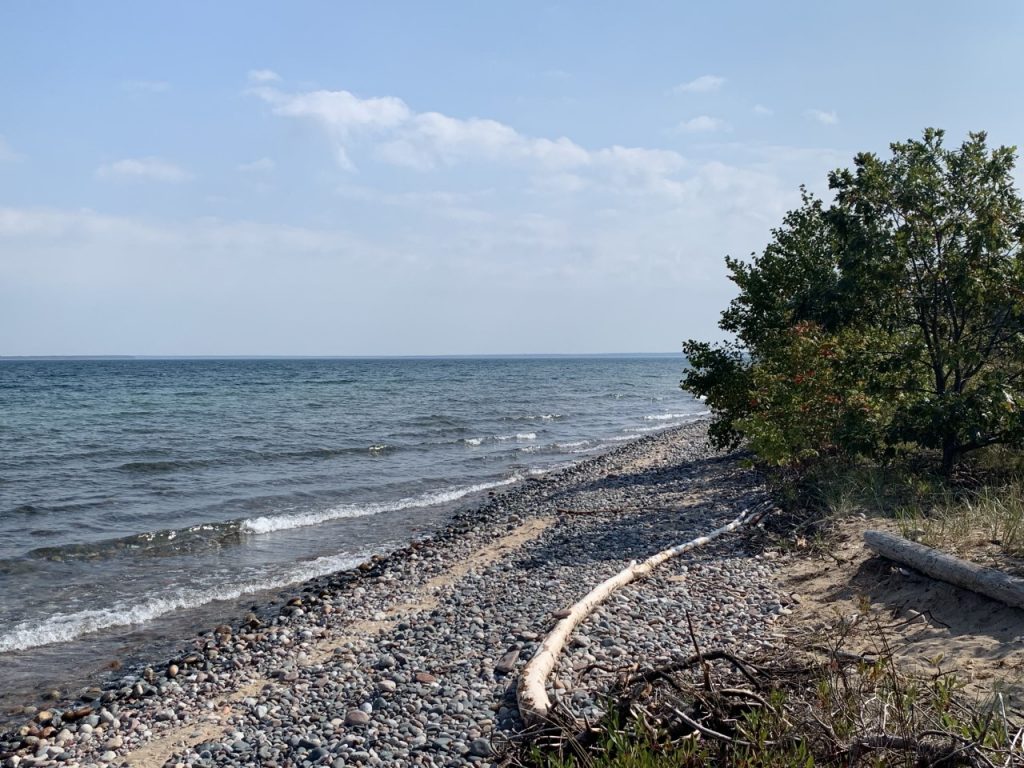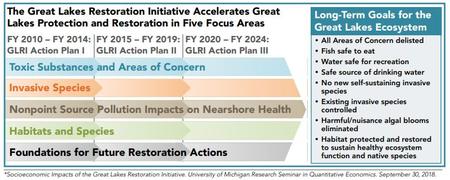EPA, Environmentalists Find Common Cause in Great Lakes; Differ on Funding, Regulation
Goals for the Great Lakes Restoration Initiative include toxic pollution and invasive species. One environmental group generally supports it, but wants to see it funded.

The U.S. Environmental Protection Agency has rolled out a new plan it says will benefit the Great Lakes. EPA Administrator Andrew Wheeler says President Trump has promised to fund the five-year effort.
“I believe it is a very aggressive plan that will address not just wastewater and harmful algae blooms, but also invasive species,” Wheeler told members of the Detroit Economic Club.
Since taking office in 2017, the administration has proposed drastic cuts to the Great Lakes Restoration Initiative. The program provides $300 million dollars annually for things like toxic pollution cleanup and restoration of fish and wildlife habitat throughout the region.

Read the Great Lakes Restoration Initiative Action Plan III here
Laura Rubin is the director of the Healing Our Waters-Great Lakes Coalition. She says the group has worked with Democrats and Republicans in Congress to preserve funding for the GLRI.
“Bipartisan support has put that funding back in the budget, and that’s something we’ve worked on very aggressively,” Rubin says.
“The Great Lakes have not been a divisive issue. They are something that we collectively care very deeply about.” – Laura Rubin, Healing Our Waters-Great Lakes Coalition
In general, Rubin says there’s a lot to like in the new EPA plan, though she hopes the agency will fully fund it.
“Great Lakes protection requires more than just a plan,” Rubin says. “It requires continued investment and stronger protections for clean water.”
Click on the player to hear Laura Rubin’s conversation with WDET’s Pat Batcheller and read a transcript, edited for clarity, below.
WDET’s Pat Batcheller: What do you see in the EPA plan that you like?
Laura Rubin, Healing Our Waters-Great Lakes Coalition: We support the investments in the plan, and the focus is similar to what it’s been for the past ten years under the Great Lakes Restoration Initiative. But Great Lakes protection requires more than just a plan. It requires continued investment and stronger protections for clean water.
We’ve seen the Trump administration roll back on both issues for the last three years. They haven’t put in the funding for GLRI. Bipartisan support [in Congress] has put that funding back in the budget, and that’s something we’ve worked on very aggressively. The administration has also been rolling back clean water protections, specifically the Waters of the United States rule covering streams and wetlands.
It sounds like what you’re saying is, “put your money where your mouth is.”
Exactly. And not only the funding, but also the stronger regulations. At the same time that [EPA Administrator Andrew] Wheeler was in town announcing this most recent action plan, he was speaking to the Detroit Economic Club about deregulation. Right now, especially in Michigan, we’re seeing crises to our drinking water continue to unfold; Flint, Toledo, lead and PFAS. It’s not a time talk about rolling back protections for clean water, but to be increasing them.
Could you cite an example of the kind of regulation you’d like to see expanded or restored?
The Waters of the U.S. rule has been a contentious issue. It’s been challenged by a couple of lawsuits. It leaves some loopholes in what is protected under the Clean Water Act. Those loopholes pertain to smaller rivers, streams and wetlands. Under President Obama, there had been a rule that tightened those up and allowed for greater protection of wetlands and streams. The Trump administration has rolled back that rule and will supposedly be coming forth with a new regulation. But we are worried because it’s those wetlands and streams that are the filters for our larger bodies of water, where we get most of our drinking water.
Why did they roll those back?
Because they thought it was an overreach in terms of regulatory authority. There has been opposition from corporations, manufacturing and the farm industry. They felt it was too much regulation, too much restriction.
According to the EPA, the plan addresses toxic pollution cleanup, invasive species, algae blooms and restoring fish and wildlife habitat. Do you generally support those goals?
Most definitely. The GLRI has been a wonderful program for the last ten years. We’ve had huge successes in the region in terms of cleaning up toxic contamination, mainly in some of our larger cities. It’s restored thousands of streams and wetlands. In general, we get about $300 million federal dollars for GLRI every year. That has spurred not only environmental restoration, but economic growth. A University of Michigan study showed that every dollar invested in the Great Lakes region through GLRI generated $3 in economic activity.
What else would you like to say?
The Great Lakes in general have not been a divisive issue for Democrats, Republicans, blacks, whites, urban, rural, rich or poor. They are something that we collectively care very deeply about, its economy, its environment, its culture and history. We were disappointed it was presented as a partisan issue, We have broad bipartisan support for the GLRI, and we hope the administration joins those efforts.
More from WDET
EPA Chief Backs Cutting Emission Standards; Protecting Great Lakes
Great Lakes Initiative Funds Projects Large and Small
Forecasters Predict Larger Algae Bloom in Lake Erie
University of Michigan Study: Socioeconomic Impacts of the Great Lakes Restoration Initiative
